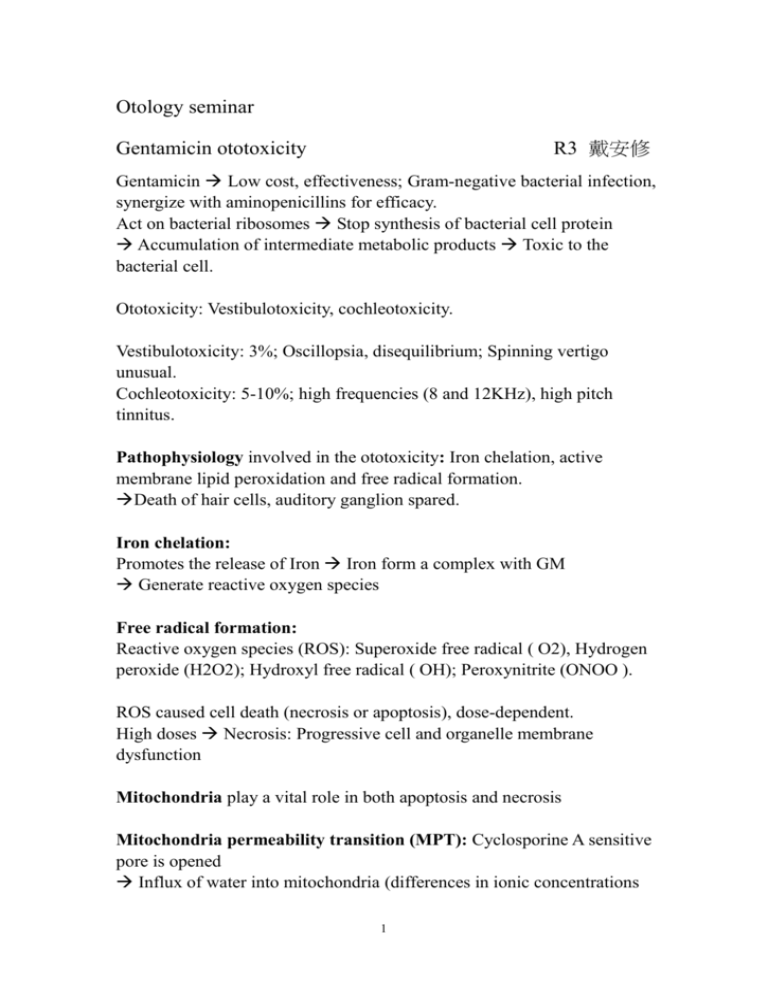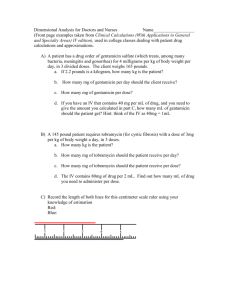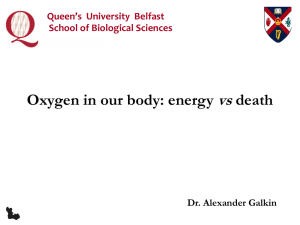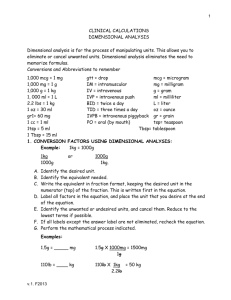Otology seminar
advertisement

Otology seminar R3 戴安修 Gentamicin ototoxicity Gentamicin Low cost, effectiveness; Gram-negative bacterial infection, synergize with aminopenicillins for efficacy. Act on bacterial ribosomes Stop synthesis of bacterial cell protein Accumulation of intermediate metabolic products Toxic to the bacterial cell. Ototoxicity: Vestibulotoxicity, cochleotoxicity. Vestibulotoxicity: 3%; Oscillopsia, disequilibrium; Spinning vertigo unusual. Cochleotoxicity: 5-10%; high frequencies (8 and 12KHz), high pitch tinnitus. Pathophysiology involved in the ototoxicity: Iron chelation, active membrane lipid peroxidation and free radical formation. Death of hair cells, auditory ganglion spared. Iron chelation: Promotes the release of Iron Iron form a complex with GM Generate reactive oxygen species Free radical formation: Reactive oxygen species (ROS): Superoxide free radical ( O2), Hydrogen peroxide (H2O2); Hydroxyl free radical ( OH); Peroxynitrite (ONOO ). ROS caused cell death (necrosis or apoptosis), dose-dependent. High doses Necrosis: Progressive cell and organelle membrane dysfunction Mitochondria play a vital role in both apoptosis and necrosis Mitochondria permeability transition (MPT): Cyclosporine A sensitive pore is opened Influx of water into mitochondria (differences in ionic concentrations 1 between the cytosol and mitochondria matrix). Outer mitochondria membrane rupture Compounds located in the intermembrane space into the cytosol. Loss of ion homeostasis, inability to maintain mitochondrial respiration and ATP level. Energy depletion and necrotic cell death. Moderate dose Apoptosis: Apoptosis Gene-directed self-destruction program Post-translational activation of intracellular signaling cascades proteins. GM Plasma membrane Activates Jun-kinase pathway Linked to receptor-mediated apoptosis Apoptosis inducing factor located at the intermembrane space of mitochondria (GM ROS Opening of mitochondria permeability pore) Released into the cytosol Active the caspase cascade (endonuclease and protease) DNA fragmentation, chromatin condensation, and rearrangement of the cytoskeleton Producing blebs. Possible treatments Antioxidant treatments and irons chelators Attenuated the formation of free radicals and blocked GM-induced damage in animal models, however no human data. Antioxidants Suppressing membrane lipid peroxidation (-tocopherol) prevent neuronal cell death in cell cultures (Mattson, 1998) Salicylate Radical scavenger and metal chelator attenuate GM-induced hearing loss in guinea pigs (Sha and Schacht, 1999). D-methionine and Brain-derived neurotrophic factors restricted the production of ROS Limited the vestibular hair cell damage caused by GM (Takumida, 2003) 2 Why high frequencies damage Glutathione concentrations lower in outer hair cells than supporting cells Lower in the cells of the basal turn as compared to the apical turn of the cochlea. Early damage to the first row of outer hair cells beginning at the basal turn of the cochlea. Explained the higher susceptibility of these cells mitochondria permeability transition by GM. Diagnosis Exposure to GM > 2 weeks, bilateral vestibular paresis. GM versus ototoxicity 1. Dose and kidney function: GM excreted almost purely by glomerular filtration Appropriate dosing interval chosen according to the renal function. <3 days less likely cause ototoxicity. 2. Potentiating medications: Increase risk of ototoxicity if other ototoxic drugs given, eg. cisplatin, metronidazole. . The drugs may not necessary be present in the same time. 3. Genetic susceptibility: Mutation of mitochondria RNA, hearing loss after one dose of GM. 4. Age: Older people approximately 50% vestibular ganglion cells have died. Prognosis People do recover from ototoxicity; slow and usually incomplete. GM ototoxicity never causes so severe imbalance as to require a wheelchair. Some “sick” inner ear hair cells get better. Nobody knows how many inner ear hair cells are sick rather than dead. Not all dead. Some remain but are not functioning at top-efficiency. The brain adapts to the missing inner ear information. Prevention No monitoring protocols can reliably prevent GM toxicity. The toxicity is delayed. May not cause clinical symptoms for a week after intake, damage can progress for months after the drug has stopped. 3 Persons on large and prolonged doses of GM, administration with a potentiating agent, significant renal disease, preexisting ear disease. References Takumida M. Anniko M. Shimizu A. Watanabe H. 2003 Neuroprotection of vestibular sensory cells from gentamicin ototoxicity obtained using nitric oxide synthase inhibitors, reactive oxygen species scavengers, brain-derived neurotrophic factors and calpain inhibitors. Acta Oto-Laryngologica 123, 8-31. Sha S.H. Schacht J. 1999 Stimulation of free radical formation by aminoglycoside antibiotics. Hear Res. 128, 112-118. Mattson M.P. 1998 Modification of ion hemostasis by lipid peroxidation: roles in neuronal degeneration and adaptive plasticity. Trends neurosci 21, 53-57. Dehne N. Rauen U. de Groot H. Lautermann J. 2002 Involvement of the mitochondrial permeability transition in gentamicin ototoxicity. Hear Res. 169, 47-55. Jukka Y. Liang X-Q. Jussi V. Ulla P. 2002 Blockade of c-Jun N-terminal kinase pathway attenuates gentamicin-induced cochlear and vestibular hair cell death. Hear Res. 166, 33-43. Fetoni AR. Sergi B. Ferraresi A. Paludette G. Troiani D. 2004 Alpha-tocopherol protective effects on gentamicin ototoxicity: an experimental study. Int J Audiolo. 43, 166-71. Discussion Ap Lin: Oscillopsia 應翻為視覺晃動, 這是雙側前庭功能低下的病患因大腦調適 所引起的 ,特別是當病患在活動時特別明顯。 另外,洗腎病患有些會有聽力的問題,有報告提出給予 EPO 對病患的聽力是有 幫助的。實驗也證實 EPO 可減緩 Gentamicin 對大鼠的 Ototoxicity。可以再看 看這方面的文章。 Gentamicin Ototoxicity 所造成的雙側前庭功能低下,大腦調適其實是很有限的。 所以上面提的 The brain adapts to the missing inner ear information 這句話還是要 存疑。 R4 謝: 臨床上有無確實可診斷的工具 Ans: 因為 Cochleotoxicity 是在 high frequencies (8 and 12KHz),早期是可用 high frequency audimetry。但是學者報告認為不是很實用。 R3 林: 病患使用 Gentamicin 後發生 Ototoxicity 最久到甚麼時候 Ans: 學者報告認為使用後數個月還是有可能會發生。 4







